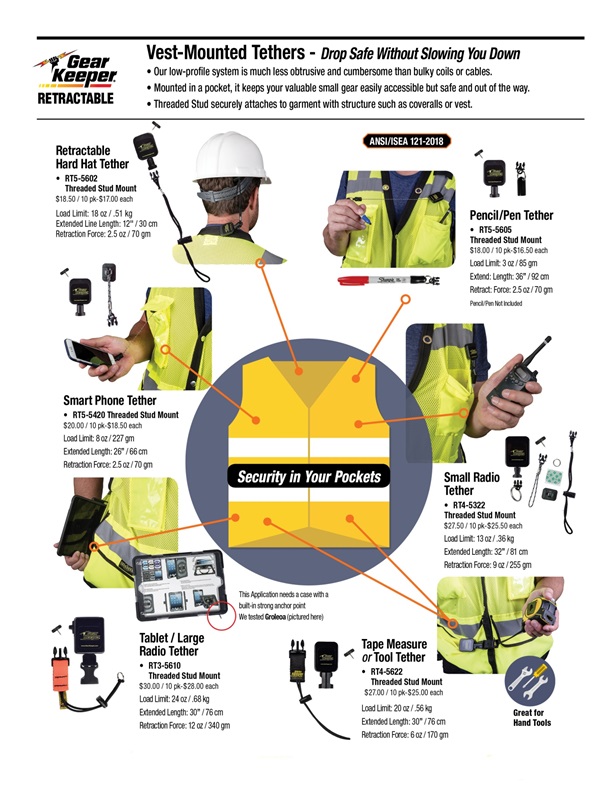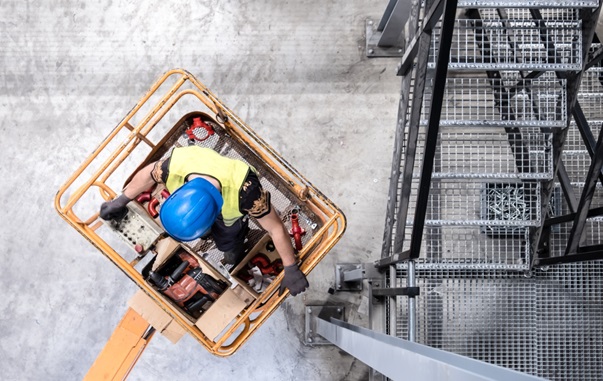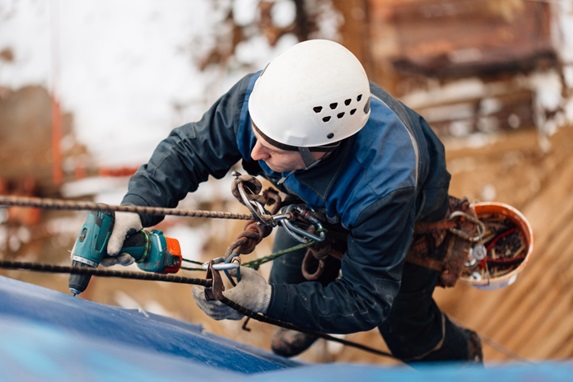Tool Tethering Stages – AVERA
Sponsored Article
Being struck by falling objects is the 5th leading cause of industrial accidents with an annual cost of billions per year. Addressing this significant but preventable safety issue, The International Safety Equipment Association (ISEA), in conjunction with the American National Safety Institute (ANSI) and major tether manufacturers, including Hammerhead Industries (Gear Keeper Tethers), has recently developed the ANSI/ISEA 121 manufacturing and performance standard for tethering tools and equipment used at heights.
Traveling across the country I am constantly talking to distributors, dealers, subcontractors and technicians about their experiences regarding dropped object safety requirements. It’s apparent that principal companies sometimes have a knee-jerk reaction resulting in dubious, and potentially unsafe dropped object policies for at-heights work.
As a decades-old manufacturer of ergonomically designed tethers and retractable tethering equipment, we have learned that in order to have a successful company-wide dropped object program, worker safety, productivity and convenience must be part of the solution. Unfortunately, shoot-from-the-hip tethering policies can have a negative affect on all three.
The comprehensive ANSI/ISEA 121 Dropped Tool Standard is the result of the first major study to delve into this at-heights issue. It’s a safety issue that was originally noted over 100 years ago (NYT, August 2, 1903), during the construction of the Williamsburg Bridge in New York City. The article stated, “Dozens of placards posted at various places on the bridge caution the iron workers to use great care in the handling of tools.” Ironically, the story cast more emphasis on “losing valuable tools” rather than injuring people on boats passing beneath the bridge.
In the early stages of corporate tool tethering policies, dropped object programs were often an impulsive reaction to a specific fallen tool (i.e. a hammer is dropped and the project is shut down until all hammers are tethered). The subcontractors would then base their own dropped object policy on the principal company’s requirements (i.e. tether all hammers). As a result, many dropped objects programs targeted only one or two tools. The subcontractors and other short-term employees would purchase cheap tethers for the specific project and specific tool(s) that were considered one-time use throwaway items (like bungee-type tethers). In some cases this situation still persists today and the unfortunate result is that safety and productivity may be adversely impacted.
Instead of relying only on the principal company’s at-heights program, subs should consider developing their own adjunct company-wide program. Bear in mind that tool-tethering systems are themselves tools just like hammers, screwdrivers and drills. And like all quality tools, tool tethering system purchases should be based on the same criteria for any tool… quality, durability, ease of use and increased convenience. Rather than buying disposable low-cost tethering products, that are thrown away after the job is completed, choose well-designed, ergonomic tethers and lanyards that will increase productivity and last longer… and make them a permanent part of the company’s tool kit.
In addition to being safer than disposable tethers, the new ANSI/ISEA-121 compatible tool tethers bring many new convenience and productivity advantages to technicians. Among them are quick-release tool interchangeability so that one tether can accommodate many tools, locking carabiners that prevent accidental release, tethers that offer maximum but gentle retraction and extension lengths, a wide range of retractable tethers that increase safety by keeping tools close to your body to avoid dangling tether accidents, tethers that are easily inspected for wear for continued safe use… to name just a few.
As things progressed, safety conscious companies took more aggressive steps to reduce their dropped object incidents. Generally they set broad guidelines for tools to be tethered, but without specificity it was a vague policy that lacked definition. A hammer is a tool but so are hardhats and tape measures, both of which can be dropped and cause injury and death (recently a tape measure dropped from an upper story of a NJ construction site killed a worker delivering materials to that site).
Furthermore budgets for tool tethers remained tied to specific projects as opposed to a company-wide tethering philosophy. In some cases solutions only consisted of giving every worker a tether or two with the instruction that technicians should connect their tools when they are by the leading edge. In other cases, too many tethers were issued creating confusion, frustration, entanglement situations and eventually lack of compliance. Either way, productivity and safety issues were not properly addressed.
Principal companies are now saying they require 100% tool tethering but what exactly does that mean? Does it mean just heavier tools such as hammers and drills, small hand tools, hardhats and tape measures, or does it mean ALL items including phones, tablets and radios? If you mean all of these items then the next question is “are you also concerned about productivity?” Remember the more tethers you add, if not done properly, will negatively impact productivity and safety. Another compliance challenge are technicians who believe that they are tethering all of their tools, when in reality they are just tethering their heavy tools like drills and/or tools that they may have dropped in the past, like hammers or spud wrenches. Their smaller tools including screwdrivers, pliers, radios or cell phones are not being tethered, any one of which can cause injury, damage or death.
It doesn’t have to be a choice between productivity and safety.
The bottom line is that principal companies emphasize at-heights safety regarding dropped tools, but are missing the broader safety goal of dropped objects. And they have no real road map for achieving this. In spite of their stated objectives, when I talk to subcontractors and ask them if they are adhering to the principal company’s 100% at-heights tethering policy, they just sort of roll their eyes.
Mating the correct tether with a specific tool or object starts with the item’s weight and a tether of the appropriate length for the item. Thanks to the new ANSI/ISEA 121 Standard there are now established minimum design, performance, and labeling requirements to guide you. This will provide a more defined path for selecting the best and most appropriate tethers that will mitigate drop hazards and at the same time improve productivity and convenience for their employees. This is very important development because ANSI/ISEA 121 compliant tethering systems include many different components (i.e. tool attachments, lanyards, carabiners and anchor points) that will work safely together even when purchased from different ANSI/ISEA 121 compliant manufacturers. Think outside the box for your tethering options. Safety, productivity and compliance do not have to be in opposition when designing and implementing your company’s Dropped Object Policy. New products have been developed that encompass all three tenets. For instance, a technician’s safety vest can now secure many of the most commonly used cell phones, large and small radios, tablets, tape measures, hard hats, and even lighter traditional tools like screw drivers and small wrenches… without fear of entanglement or wasted time changing out tools.without fear of entanglement or wasted time changing out tools.
Example 1 – Security in your pocket

New ANSI/ISEA 121 compliant, vest-mounted retractable tethering products offer drop safety security and convenience without impeding productivity. These unobtrusive, low profile retractables keep small gear readily accessible but safe and out of the way without using bulky cables or coils. This applies to coveralls and other clothing as well as vests. Remember, it is important to mount tethers in clothing with structure and not in the mesh material.
Example 2 – Working from a lift bucket

Tools can be stored in an ANSI/ISEA 121 compliant tool bag set on the bottom of the lift. However once the tool bag is opened, it too becomes a potential drop hazard (i.e. if the bag is accidentally kicked or falls, or a tool is dropped picking it up). Consider kick boards or barricading of the lift to prevent the above.
- If tethers are required (i.e. dropped object prevention is not solved with barricades or netting) all tools that are going to be used must now be tethered.
- Are tethers attached to the lift or the person and how many are being used? If only using one or two tethers, consider potential productivity and drop issues each time a tool change is required.
- Using the waist style tool bag with 5-6 tools tethered is one solution to minimize tool change-out or bending over.
- Make all tool change-outs in a safe zone (i.e. down inside of the lift that has protective sides).

100% JOB SITE TIE-OFF… THINGS TO CONSIDER.
Following are some basic suggestions for developing a program that will accomplish a safer environment without sacrificing productivity and safety of those working at heights and everything and everyone that is below them. Remember it’s not for you; it’s for your coworkers and their families.
100% tie-off is a dropped object policy not a tool tethering policy.
Tool tethering is just one aspect of solving dropped object danger. Obviously tethering heavy tools like hammers, drills & spud wrenches are mandatory but so are lighter tools like pliers, screwdrivers & tape measures as well as cell phones, radios and tablets.
Scale down the number of tools being used at-heights.
When working at heights you may not need a complete tool kit. Analyze the requirements of job and pick only the tools that are necessary to complete the assignment, and then provide tethering solutions for just those tools.
Be sure to consider convenience when selecting tethers.
Wherever possible select high quality “Smart” tethering products that feature ergonomic design aspects such as retractable tethers that keep tools close to the body. This will minimize entanglement issues when climbing or working in close quarters. They will also enhance productivity and lower cost by increasing longevity of use.
Improve productivity for worker morale and compliance.
Look for application-Specific/Ergonomic retractable tethers that will reduce impact on productivity. “Smart” tethers and lanyards should offer easy quick release tool change-out to minimize down time and other safety concerns. Arm strain and muscle fatigue can be reduced by tethers that use an integrated woven elastic throughout the body of the tether creating a short retracted length and requiring the least effort to stretch to the longest extension length.
Always look for the ANSI label, it can tell you a lot.
All manufactures that adhere to the ANSI standard must include a label showing basic but necessary information.
- Name, trademark or other means of identification of the manufacturer.
- Product identification for tracking the product service life by period of use.
- Published capacity(ies), identified by weight.
- Number of the specific ANSI standard.
- Tether length (for tool tethers only).
In broad strokes, I have briefly covered some of the main elements of the new ANSI/ISEA 121 standard and how it applies in helping you develop your own company’s At-heights Dropped Object Policy. Gear Keeper has also created a short video with additional information at https://youtu.be/WXXgykeleAc.
I recommend that you contact the International Safety Equipment Association (ISEA) for more information to purchase a copy of the standard that they sell for $30. ISEA link: https://bit.ly/2LkwxQV. For more information please contact customer service at Hammerhead Industries Inc. (888) 588-9981. You may also visit www.gearkeeper.com.
About Hammerhead Industries:
John Salentine is the co-founder and Vice President of Hammerhead Industries. Gear Keeper tool tethering systems are products of Hammerhead Industries, Inc the world’s leading manufacturer of unique personal safety tethering equipment including retractable tethers and lanyards for tools, gear and instruments. Covered by numerous patents, Gear Keeper tethers are precision-made systems that keep tools and instruments safe, secure and close at hand. With more than 3,000 configuration options and millions of systems in use, Gear Keeper tethers are found worldwide in a range of applications including industrial safety, construction, fire/rescue, law enforcement, military, wind power generation, trucking, oil and gas exploration, outdoors/hunting, SCUBA/fishing, communications and more. All of the company’s products are built in the USA.
About ANSI & ISEA:
ANSI is a century-old, private, not-for-profit organization that promotes “voluntary consensus standards.” The purpose of ANSI and the standards they and ISEA put forth is to set a level of quality and safety across an entire industry. The new standard is the first of its kind to address equipment used to tether and/or contain hand tools, components, and other objects from falling from at-heights applications.
